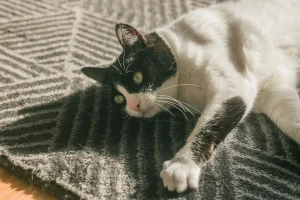There’s an unspoken rule in the feline world: If you’re going to vomit, always aim for the carpet. It’s as if your cat knows just how to push your buttons, choosing your prized Persian rug over the easily cleaned tile floor every time. You’re not just imagining it; there seems to be a method to their madness.
In this blog post, you’ll learn exactly why your furry overlord opts for the plush comfort of your carpet when it’s time to upchuck, and more importantly, what you can do about it.

Quick Takeaways:
- Cats prefer carpets for vomiting due to their need for comfort and privacy during vulnerable moments.
- Addressing frequent vomiting starts with diet management, regular grooming, and consulting a vet for health issues.
- Quick clean-up involves using paper towels to remove vomit, blotting with a damp cloth, and applying pet-safe enzymatic cleaners.
Why Do Cats Prefer Carpets?
Have you ever wondered why, when your cat feels the urge to vomit, they bypass the easy-to-clean tile floor and opt for the plush carpet instead? It turns out, there are a few reasons behind this peculiar choice. Firstly, cats instinctually seek out soft, comfortable places when they’re not feeling their best. The soft texture of a carpet may provide a sense of security and comfort during their vulnerable moments.
Moreover, cats have a natural instinct to seek privacy when they’re sick. Vomiting makes them feel exposed and weak, so the carpet, often located in less trafficked areas, offers a sense of obscurity compared to the wide-open, more exposed spaces where hard flooring is common.
In essence, it boils down to their innate need for comfort and security during what is naturally a distressing time. Understanding this preference can help us become more empathetic towards their needs, even if it’s at the expense of our beloved rugs.
Health Reasons Behind Frequent Vomiting
Frequent vomiting in cats isn’t just a quirky habit; it’s often a signal that something’s amiss health-wise. Let’s delve into the common culprits:
-
Hairballs : Cats groom themselves by licking their fur. This can lead to the ingestion of hair which can accumulate in the stomach and form hairballs. While it’s a normal occurrence for cats to expel hairballs, excessive vomiting may indicate it’s time for a grooming aid or a vet visit.
-
Dietary Issues : Cats can be sensitive to certain foods or may develop allergies, leading to gastrointestinal upset. It’s pivotal to pinpoint if a specific food is triggering your cat’s symptoms. Sometimes, switching to a limited ingredient diet or a hypoallergenic food can make a world of difference.
-
Illness : Frequent vomiting might also point to underlying health issues such as kidney disease, hyperthyroidism, or even diabetes. If your cat’s vomiting persists, it’s crucial to consult with a veterinarian for a thorough examination and prompt diagnosis.
Understanding the root cause of your cat’s vomiting is the first step towards ensuring they get the care they need to prevent any serious health issues.
How Can You Prevent Your Cat From Vomiting on the Carpet?
Addressing the issue of your cat vomiting on the carpet involves a two-pronged approach: managing the underlying health reasons and making strategic changes to your home. Here’s how you can do both:
-
Diet Management : Pay close attention to your cat’s diet. Opting for easily digestible, high-quality cat food can reduce the risk of stomach upset. Consult with your vet to find the best dietary options for your feline friend.
-
Regular Grooming : To combat hairballs, incorporate regular grooming into your routine. This not only minimizes the amount of hair your cat ingests but also serves as a bonding experience.
-
Provide Alternatives : Here’s a unique tip – create a designated ‘safe vomiting spot’ for your cat. Choose an area with hard flooring and place a washable mat or towel there. You can gently guide your cat towards this area when you notice the pre-vomit behavior. Cats can learn to associate this spot with vomiting, sparing your carpets in the process.
Implementing these strategies requires patience and consistency, but it can lead to a significant decrease in carpet incidents. Plus, understanding and addressing the health concerns behind your cat’s vomiting will not only save your carpets but, more importantly, contribute to a healthier, happier life for your feline companion.
Immediate Actions to Take When Your Cat Vomits on the Carpet
When your fluffy friend decides your carpet is the perfect spot to vomit, it might be frustrating, but there’s no time to waste. The key is acting fast to prevent stains and odors that can linger. Here’s a step-by-step guide on handling the situation with care and speed:
-
Remove the Bulk, Carefully : Firstly, using a paper towel or a disposable cloth, gently pick up the vomit to avoid pushing it deeper into the carpet fibers.
-
Blot, Don’t Rub : Take a damp cloth and blot the area. Rubbing can spread the stain wider or embed it further into the carpet.
-
Choose Pet-Safe Cleaners : Opt for pet-friendly cleaning solutions that are free of harsh chemicals. Enzymatic cleaners are especially effective as they break down proteins and can eliminate odors and stains. A popular choice is Nature’s Miracle Stain and Odor Remover, widely regarded for its effectiveness and safety.
-
Test Before You Treat : Always do a spot test with your chosen cleaner on a hidden section of your carpet to ensure it won’t cause discoloration.
-
Apply the Cleaner : Following the instructions on the product label, apply the cleaner to the stained area. Let it sit if required, then blot up the cleaner with a clean, dry cloth.
-
Air Dry : Let the area air dry completely. Avoiding heat drying as it can set any remaining stain into the carpet fibers.
-
Odor Removal : If a smell persists, sprinkle baking soda over the area once dry, let it sit overnight, and vacuum it up the next day. This natural method helps absorb any lingering odors.
Long-Term Solutions to Protect Your Carpets
While immediate action can minimize damage, thinking ahead can save you a lot of headaches (and heartaches) over your beloved carpets. Here’s how:
-
Carpet Protectors : Consider applying a carpet protector which adds a barrier against stains. This can be a lifesaver, making cleanup from any future incidents far easier.
-
Training Pads : Gently guide your cat to use training pads or easily washable rugs for those irresistible moments they need to vomit. It might take some patience and positive reinforcement, but it’s certainly doable.
-
Feeding Practices : Sometimes, vomiting can be managed by adjusting feeding practices. Smaller, more frequent meals can be easier on your cat’s stomach. There are also specially designed “puzzle feeders” that slow down fast eaters and can help reduce vomiting.
-
Restricted Access : As much as we love our furry companions roaming freely, consider setting up pet gates or using pet-friendly deterrent sprays on certain carpeted areas when you can’t supervise. This isn’t about restricting their joy but protecting your carpets from unexpected accidents.
A Unique Insight:
For those who have a keen interest in holistic approaches, introducing a small amount of pure pumpkin (not pumpkin pie filling) into your cat’s diet can aid digestion and potentially reduce instances of vomiting. This tip isn’t widely discussed but can be a natural and simple addition to your cat’s diet that may make a significant difference. Always consult with your vet before making dietary changes, though!
Remember, while these suggestions can minimize the impact on your carpets, it’s also essential to monitor your cat’s health. Frequent vomiting can be a sign of a more significant health issue, so if it’s happening often, a visit to the vet is in order. Let’s keep our feline friends happy, healthy, and our carpets clean!
Alex, a passionate animal lover, has experience in training and understanding animal behavior. As a proud pet parent to two dogs and three cats, he founded AnimalReport.net to share insights from animal experts and expand his knowledge of the animal kingdom.




